Braj Bhoomi Mohini: Shri Giriraj The Mount Blessed by Shri Krishna’s Touch
The mellifluous sound of his flute draws the gopis, out of their homes in a romantic dalliance with Krishna. More than a musical instrument; the flute is the breath of love and a call to eternity. Along with his most beloved Kishori Shri Radha and the gopis Lord Krishna comes to the lowlands of Giriraj, a witness and creator of their divine love.
To protect his devotees, he has adorned this massive form of the Mount. All six seasons flourish in their most glorious state in the boulders, caverns and nikunjas draped with blossoms and creepers. This idyllic and sensuous landscape provides the perfect setting for the sweet love of Lord Krishna. During the day he grazes cows with his gopas and at night dallies romantically with the gopis. Kamdev, God of love, and his wife Rati blush on observing their madhurya or sweet love.
Lowlands of Mount Goverdhan, Devotional Site of the Ashtachhap Kavis
The lowlands of Shri Giriraj has been the prime devotional site of ashtachhap kavis ( eight Krishna poets who lived in Goverdhan during the later sixteenth century) all said to be disciples of Shriman Mahaprabhuji and Gosai Vithal Nathji. Highly revered Usha Bahenji, Lord Krishn’a own Sakhi, was sent to earth for expressing his leelas or divine play. The experiences bestowed by her are treasured amongst the slopes of the mount till date.
Lord Krishna Lifts Giriraj
Shri Giriraj is extremely fortunate because Lord Krishna lifted it on his little finger for seven days at a stretch to protect Brajwasis from the fury of Indra’s devastating rain. As mentioned in the ‘Puranas’ the mount was cursed and shrank inch by inch. Though it’s seven kos length, the blue-hued boulders, dense foliage, mushrooming kunds and sarovars attracts thousands of devotees. The diety of Braj, it fulfills all their desires. Followers religiously circumambulate the mountain on Purnima and Amavasya with several ascetics and saints residing in its lowlands to pray.
Importance:
Shri Giriraj is blessed because it here that Lord Krishna spreads his joy and expresses his love. If one circumambulates the mountain just once he is expiated from all sins. Finally attaining his favoured deity, he goes to Vaikuntha because Shr Radha’s Pranvallabha or Lord Krishna adorns the peak of Shri Govardhan.
Manifestation:
King Bahulashav curious to know about the manifestation of Shri Giriraj from Shri Naradji, considered the heart of Lord Krishna, was enlightened. Initially the massive form of Sheshnaag appeared with the highly revered Golok in his lap. In the same fashion, the female Godhead, Shri Radha, the Lord’s hladini shakti or blissful energy, sprang from His left side. Shri Lalita and Vishaka rose from her two arms along with several sakhis. Shri Radha entreated the Lord for an idyllic haven in Vrindavan, on the banks of the Yamuna amidst nikunjas, which would be a perfect setting for their Raas or divine love.
Looking at his heart the Lord contemplated of such a sensuous place. Miraculously in an instant, a radiant mass fell on earth, soon transforming into a mountain. Lord Krishna is himself manifest in Shri Giriraj and Surdasji has sung paeans in its splendour.
Entrance to Braj:
Pulatsya Muni
Journeying, Muni Pulatsya ji once came to Shalmali Island and was thrilled to sight Shri Giriraj, son of Dronachal. He requested Dronachal for taking his son to Kashi, the abode of Lord Vishveshwar. The father agreed half-heartedly. With his divine power Pulatsya ji rested the mount on his palm but was forced to put him down within the Braj region. This is precisely what Shri Giriraji wished because he never wanted to leave the abode of Lord Krishna’s playful dalliance. Abiding by his earlier vow of not going ahead once he was put down, he remained implanted there. Angered at the impediment in his mission, the Muni cursed the mount saying he would shrink inch by inch everyday. Its majestic glory of hundred years ago has been affected and the mount seems different as of today.
Hanumana Carried Giriraj on His Shoulders for the Setubandh
Another episode famed in the Varaha Purana is related to the Rama Incarnation in the Treta Yuga. During the formation of the Setubandh (bridge of rocks from India to Shri Lanka) Hanumanji flew with Giriraj perched on his shoulder. The deities forecast that the bridge had been completed and Hanumanji planted the mount wherever he was. In deep anguish on not sighting the Lord’s feet, Giriraji was assured by Lord Rama that he would be the supreme site worshipped by devotees of Lord Krishna. Hanumanji also confirmed that when Devraj Indra lashed Braj with a downpour, Lord Krishna would lift the mount on his little finger for the protection of Braj denizens for seven days. Lord Krishna acknowledges Shri Giriraj as his own form.
Shri Radha Kund and Shri Krishna Kund:
Shri Radha-Krishna Absolve Our Sins
Shri Radha and Krishna Kund absolve all sins and bless us with the worship of Lord Krishna. On reading certain stotras (hymns of praise) religiously on the banks of Radha Kund one benefits with the grace of Lord Radha-Krishna. In the same fashion as Shri Radhaji is the supreme beloved of Lord Krishna the pond is extremely dear to her. Bathing in Krishna and Radha Kunds on Krishanashtami of the Kartik month, one attains the same fruition as performing the Rajsuya and Ashvamegha sacrifices. Hordes of Vaishnavas throng this site in the Kartik (eighth month of the Hindu lunar year,October-November) month and on the festival of Diwali.
Arishtasur Felled by Lord Krishna
The Puranas authenticate their appearance. Worried at the end of demonic forces, Kansa deputed demons Arishtasur and Keshi to kill Lord Krishna. The Lord plucked the horn of Arishtasur guised as a huge bull and slayed it. Several cowherds accused him with the sin of killing an animal and Shri Radha with her sakhis had to distance herself from him.
The Krishna Kund
The site ripped by the kick of his heel became famous as Shri Krishna Kund and blesses us with religion, work and salvation. Lord Krishna bathed in this pond with his sakhas and made several offerings; a perfect rendezvous forthe Raas of Shri Radha-Krishna.
The Lord ascertained that in the same way as he is the destroyer of Arishtasur this site will expiate grave sins and alleviate suffering. Motivated by the Lord, Shri Radhika along with her sakhis inaugurated the enchanting Shri Radha Kund which blesses us with all joys and worship of Lord Radha-Krishna. All pilgrimages sites merged and stepped into Shri Krishna Kund and since its waters filled the Radha Kund they resided in both of them.
Actually these kunds arose from Golok where Lord Krishna and Shri Radha reside in its enchanting nikunjas amidst the loving service of their sakhis. All of a sudden overcome by Shri Radha Bhava, Krishna assumed that he was Radha. Overwhelmed by Shri Krishna Bhava, Shri Radha was forlorn at their separation and tears streamed down her cheeks. On Shri Krishna’s reciting the Radha Mantra, Shri Radha along with her sakhis was drawn to him. He stated that the kund or pond filled with her tears of anguish will be known as Shri Radha Kund and his will be famed as Shri Krishna Kund. They playfully frolicked in both the ponds and returned to their respective forms. By the grace of Shri Radha-Krishna Kunds in Golok the two ponds were incarnated in Vrindavan.
Shri Krishna Kund is also famed as Arishta Kund after the killing of Arishtasur. Vajranabhji with the help of Shandilya Muni had established these kunds. But due to their disappearance in the intervening time, Chaitanya Mahaprabhu threw light on these sites. Shri Raghunathdasji meditated on the northern banks of Shri Radha Kund and because of his wish the celestial miracle resulting in the restoration of the Shri Radha and Shri Krishna Kunds took place.
Restoration of the Twin Kunds:
Left with dwindling water, the sites became obsolete and were known as Kari and Peeri by the innocent Brajwasis. Shri Raghunath Dasji bathed in these kunds with no potable water nearby and yearned for them to be flowing again. A miracle took place. Some devotees visited Shri Badrinarayan and offered a whole lot of mudras or gold coins. Appearing in their dreams the Lord asked them to take the money to his devotee, Shri Raghunath Dasji, residing in Aarit village near Mount Goverdhan. They headed towards Aarit village and narrated the incidence to Raghunath Dasji.
Stunned, he knew it was God’s wish and praising the devotees as his medium, had the Krishan Kund dug. Five peepul trees sat on its northern bank.Yudhistarji confirmed in a dream that the trees were in fact five Pandavas doing penance for attaining Braj and requested Raghunath Dasji for not being uprooted. The orders were revoked. Till date it seems that Shri Krishna Kund is not square-shaped like Radha Kund with its northern bank not being in a straight line.
The Twin Kunds as a pilgrimage site:
Shri Radha Kund
Shri Radha Kund is suffused with celestial love. Shri Radha-Krishna, divine incarnations as human lover and his beloved along with their several sakhis are forever engrossed in the sheer sensuality and serene spirituality of their romantic dalliance. Sitting on its banks, playing the melodious flute, the breath of his love, Lord Krishna draws the cows and attracts the gopis, captivating all.
Shri Krishna Kund:
Shri Radha, the female Godhead, bathes here daily. The site is extremely dear to her; very much like she is the most beloved of Lord Krishna. To its north is Madhu Manglananda Kund which is shaped by Shri Lalitaji. To its north-east is Ujvala Nanda Kund belonging to Ujvala Sakha and adorned by Vishakaji.
Jeeva Mandir:
The temple is close by. Here a boulder is shaped as Giriraj’s tongue and revered.
Shri Radha Vallabha Ghat:
When Shri Hit Harivanshji Maharaj came to Vrindavan he was drawn by Shr Radha Kund and resided on its banks. The idols of the Lord and his beloved adorn the Shri Radha Vallabha temple on Vallabha Ghat.
Shri Chaitanya Mahaprabhu’s Baithak:
On the right side of the parikrama (circumambulation) is a tree where Mahaprabhuji sat and rested while journeying to Braj.
Shri Manmahaprabu Vallabharyaji’s Baithak:
Situated at Vallabha Ghat is this site where he stayed for a month and held the Bhagwat Saptah.
Vajra Kund:
Cuddled in the lap of Shri Shyam Kund is Shri Vajra Kund created by Shri Vajranabhji. The temples of Shri Banke Bihariji, Shri Madan Mohanji, Shri Radha Madhavji and Shri Sita Nathji encircle Shyam Kund.
Shri Lalita Kund:
A huge kund is located on the left side of Shri Shyam Kund. In the same fashion as Lalitji is very dear to Lord Krishna he is very fond of this site. A dip in this pond absolves all sins and blesses us with dedicated worship of Shri Radha-Krishna. Shri Nivasacharyaji did penance here and authored ‘Vedanth Kaustubhbhashya’ and ‘Laghustvaraj’. Shri Lalita Bihariji is situated at this pond.
Shri Radha Kund:
Close to Krishna Kund, Shri Radhikaji inaugurated this kund by embracing Shri Krishna. Bathing in Shri Radha and Sri Krishna Kunds one is freed from the grave sins of killing Brahma, cows and men thus attaining the fruits of Rajsuya and Ashvamegha sacrifices.
Ashth Sakhi Kunj:
The Ashtsakhi Kunj
Unsurpassed in beauty, embellished with fragrant lotuses, the dalliance of Lord Krishna and Radha abounds in these bowers. Mesmerized by the dense foliage are Shri Lalitananda and Vishakhaji’s Madan-Sukhad Kunjs. Bejewelled pillars, enchanting stairs, chirping birds and blossoming flowers adorn these sites. The six seasons bloom in all their glory wherever Lord Krishna ventures. The Lord dallies on this heaven called earth, sometimes during the Jhoolna Utsav and at times engrossed in the twinkling anklets during Raas (rapturuous dance). Enraptured, Shri Radha is focused on Lord Krishna as she clings to him with endearing gestures.
Chitrananda, Puranendu, Hem, Manohar, Arun and Hari Kunjs dot the ambience. At Hem Kunj there is a kitchenette where Champkalaji cooks for Shri Radha-Krishna.
Lagmohan Site:
On the east of Shri Radha Kund, nestled amidst trees is Lagmohan Site and Kund. While grazing cows Lord Krishna often met Shri Radha at this picturesque site.
Shri Radha Kund Confluence site:
Those who sight the Radha Vallabha idols at the merging site of Shri Radha and Krishna Kunds and bathe in these two ponds definitely attain the Lord’s love.
Shri Radha-Krishna Temple:
Bathing in the kunds, sighting Kundeshwar Bhagwan Shankar and worshipping Shri Radha-Krishna one fulfills all desires. Goswami Vithal Nathji handed over the service of the twin idols to Baba Gopaldas. Deities Shri Radha-Krishna are resplendent in this temple.
Other Sites:
Shri Mannityanandji’wife’s Temple, Kaviraj Shri KrishanDasji’s Samadhi, Shri Manniityanandji’s Temple, Mahaprabhuji’s Temple and Shri Vrashbhanu Kund are worth a visit.
Malyahari Kund:
The site lies to the west of Shri Radha Kund. Sitting in Madhavi Kund, Shri Radharani strung the pearl necklace together. Brajwasis gathered at Goverdhan to celebrate the festival of Diwali. A group of gopis began stringing a pearl necklace with the perspective of adorning Radhaji. Lord Krishna requested for some pearls but was refused. Impatient, he got some from his mother and planted them in Yamunaji. Soon enough they blossomed into flowers decked with pearls and had the gopis begging for some. Lord Krishna initially refused but gave in after a certain condition which Soordasji has expressed beautifully in his compostions.
Shri Radhakant Temple (Kusum Sarovar):
The Kusum Sarovar
On returning from Shri Radha Kund this temple enroute is adorned with big buildings and was set up by Shri Balwant Rao Maiya Saheb. An exquisite idol of Shri Radhakant Thakurji adorns the shrine.
Kusum Sarovar (Uddhava ji’s Darshan):
The queens of Dwarka pained by their separation from Lord Krishna came to Braj and relating their anguish to Goddess Kalindi, were at peace. The goddess didn’t feel the pathos of the Lord’s separation because she had acquired the Shri Radha Mantra.
Shri Uddhava Giving Krishna’s Message to the Gopis
She guided them to Uddhavaji who had helped the gopis when Shri Krishna had gone to Mathura with Shri Akroorji, leaving them behind in Braj. He was resplendent near Goverdhan to attain the dust of the gopis’ feet. They did the same and miraculously Udhavaji appeared from the overgrown thicket. He assured them of being blessed with the devotion of Shri Krishna because of which the Lord had instructed Arjun to send them to Braj.
They were 16,000 in number and Lord Krishna’s innate skills had been divided into 16 segments. Shri Vajranabhji’s (great-grandson of Lord Krishna) place is at the feet of the Lord and because of Yogmaya (Lord’s creative power) the queens had forgotten their identity and were grieved. Udavaji confirmed that at the end of the Dwapar Era they would have Lord Krishna’s darshan or glimpse. He had the Shrimad Bhagwat read and miraculously Lord Krishna appeared. Shri Vajranabhji along with his maternal group became one with the Supreme Being. At midnight, on the banks of the Kusum Sarovar, Krishna dallies with his beloved Radha beneath an Ashoka Tree.
Shri Narayan Swamiji:
Born in Rawalpindi, Swamiji had faith in saints since childhood. Hearing about ethereal Vrindavan he came here and spent his life in austere penance. Wandering around in a trance, Shri Narayan Swami yearned for a glimpse of lord Krishna. In 1957 he united with the Lord at Kusum Sarovar. Udhava Kund is behind this site and Udhavaji resides amidst thickets.
Shri Narada Kund:
Shri Narad ji
Shri Naradji did penance at this pond for attaining a gopi form. It is an accepted Hindu Doctrine that the questing human soul is feminine; the only male is Lord Krishna and the rest are all gopis. Naradji considered Lord Krishna’s heart, could only witness his Raas or raputuruous dallance after being born as a cowherdess. Lord Shankar resides in the Gopeshwar form, adorned as a gopi, at Vrindavan to sight the Lord’s amorous escapades.
Acquiring the Gopal Mantra from Shri Brahmaji, Shri Naradji prayed for the gopi bhava (love flowing towards the Lord); overwhelmed with a desire to witness the madhurya or sweet love of Lord Krishna with the Brajbalas. Shri Kusumadevi guided him to bathe in the Kusum Sarovar and instantly he transformed into a beautiful gopi. Shri Van Devi helped him enter the world of Lord Krishna’s dalliance and he was ecstatic.
Shyam Kuti:
Close to Kusum Sarovar, Lord Krishna entered the bower decked with dark ornaments and clothes. Being dark-hued, the gopis couldn’t recognize him. The peaceful environs of the picturesque Shyma Kuti remind us of the Lord.
Ratan Sinhasan:
During the days of Basant or spring Lord Krishna, the focus of the ardour of the gopis, whose passions he arouses, dallies here with his beloved Shri Radha.
Shri Gopal Kund (Gopal Pokhar):
At midday Lord Krishna rests at the Gopal Kund while grazing cows along with his gopas. The site is woven with tales of Subal and MadhuMangal; their fusions of delight and desire as they frolic along.
Sant Niwas:
A revered site, saints and devotees are looked after religiously with no discrimination whatsoever at Sant Niwas. Shri K.P.Ramanuj Das, the creator of this dwelling-place, was very benevolent. The Hari Gokul Teerth is closeby, where Shri Nand Raiji stayed along with his supporters.
Kilol Kund:
The kund is situated on the east of Shri Hari Gokul Teerth. As the name suggest it is a witness and creator of the various dalliances of Lord Krishna with Shri Radha. Shri Kilol Bihariji’s idol is worth a visit.
Goverdhan Village:
About thirteen miles from Mathura, with mushrooming pilgrimage sites, Goverdhan is an ancient sacred place of Braj and its significance is largely due to Mount Giriraj. Earlier Yamunaji flowed through its lowlands and during the rainy season the river can still be sighted.
Mansi Ganga:
The Mansi Ganga
Bathing in the Mansi Ganga, visiting Shri Haridevji and circumambulating the Annakoot region one gets rid of all sins. To free himself from the offense of killing the bull Vrishbhasur, Lord Krishna miraculously manifested the Mansi Ganga from his manas or mind. The river is pious and absolves all sins. Once all the gopas were preparing to venture for a dip in the Ganges. Lord Krishna reasoned that all pilgrimage sites reside in Braj but they overlooked his opinion considering him a child. The Lord produced the Mansi Ganga instantly from his mind. Overjoyed everyone bathed in it and since it was the festival of Diwali did Deep Daan (lamp-offering).
Nauka Leela (In Mansi Ganga):
Nauka Leela
Lord Krishna and his beloved Radhaji were keen for boating. Ferrying the boat in Mansi Ganga, the Lord rocked it purposely and Priyaji clung to him in fear. The incidence led to an unprecedented dalliance with the Lord captivated by the sheer sensuality of his beloved Shri Radha. Shri Gangaji, a witness to these amorous frolics, destroys all earthly drawbacks and blesses us with the worhip of Lord Krishna.
Shri Hari Devji:
The Goverdhan form of Shri Krishna resides as Shri Har Devji Thakur, lifting Mount Goverdhan as it were and is the protector of gopas. He was resplendent here during the Mughal invasion. Shri Keshavacharyaji dreamt that the idol should be transported from Bilchoo Kund and be enshrined in a temple at this site
Brahma Kund:
Lord Brahma and other deities gathered here and performed abhishek or religious ablutions on Lord Krishna. The water which gathered from this ceremony is called Brahma Kund.
Mansa Devi:
Situated on the southern bank of Mansi Ganga, Braj’s extremely ancient Devi is enshrined in a temple here.
Chakra Teerth:
Famed by the chakra or discus of Lord Krishna, Chakra Teerth is the destructor of all sins.
Shri Chakreshwar Mahadev:
I make obeisance to you who are resplendent with five faces and a protector of the Braj region. When Lord Krishna lifted Shri Giriraj to save Brajwasis from the fury of Indra’s downpour, the discus of the Lord hovered over the mount and absorbed the rain during this time span. Four forms of Mahadevji are famous in Braj and at Goverdhan he resides as Chakreshwar Mahadev.
Shri Manmahaprabu Vallabhacharyaji’s Baithak:
He stayed here for a week and got the Shrimad Bhagwat read.
Shri Sanatan Goswami’s Bhajan Kuti:
At a secluded place near Chakreshwar Mahadev, Shri Sanatan Goswami did bhajan but mosquitoes were an impediment to his worship. Helpless he thought of shifting but Mahadevji assured him that they wouldn’t trouble him in future. Having turned frail and old he continued with the tough parikrama. Soon enough a child, said to be Lord Krishna, imprinted his foot on one of Giriraj’s boulders and said circumambulating it would get him the same blessing as the Goverdhan Parikrama.This rock can be sighted in Vrindavan at the Radha Damodar Temple.
Sidh Shri Krishan Das Baba:
Throwing light on the meditaion of Gaudiya Saints, Sidh Baba spent his earlier life in Jaipur and Nandgram. With Shri Radha’s grace he came to Chakreshwar. Shri Sanatan Goswamii and Lalitaji gave support and he wrote religious and Vaishnava texts. ‘Gutika’ describes the sheer sensuality and serene spirituality of Shri Radha-Krishna’s love.
Shri Laxmi Narayan Temple:
You are the bestower of happiness and reside in Goverdhan.
Shri Shathkoop Muni:
Close to Shri Giriraj, this seat of the Shri Sect is prevalent since the sixteenth century. In spite of being a devotee of Lord Laxmi Narayan, Shri Shathkoop Muni had immense love for Shri Krishna. He wrote the text ‘Sahasra Geeti Saar’ bequeathing to us a vast visual record of Shri Krishna’s Vrindavan Leelas or divine play. A renowned acharya of the Ramanuja Cult he lived in the south but was attracted to Braj.
Indra Dwaj Vedi:
Situated on the east of Goverdhan, Nand Raiji did Indra Pujan at the Indra Dwaj Vedi, which was later changed to Goverdhan Pujan by Lord Krishna.
Rinh Mochan and Paap Mochan Kunds:
Both the ponds are in shambles. One of them has been transformed to an electricity board.
Daan Ghati:
Daan Ghat
Lord Krishna, the dark-skinned cowherd is hungry for the food of sacrifice which he is adept in demanding from the gopis who are hungry for the fulfillment of love. The regime of selling milk and curd is prevalent since ages. The gopis venture out daily but their mission is the quest for irresistible Krishna, longing for a glimpse of him which often leads to their returning home with the entire supply. At times he blocks their path as they walk through the narrow lanes of Giriraj, ardently entreating for some of the dairy products. Daan Ghati, a secluded site of Giriraj, is fortunate to witness these delightful anecdotes.
Laxmi Narayan Temple (Hathras Vala):
Bhagwan Vishnu and Laxmiji are resplendent in this temple. Panditji Maharaj was engrossed in Bhajan Leela here.
Revered Pandit Gaya Prasadji:
He was born in the Kalyanpur village of Fatehpur. Later he came to Hathras and got married, working in a factory with honesty. The renunciation and penance of revered Udiya Baba became his ideal.
Pandit Gaya Prasad ji
Leaving the children he ventured to Vrindavan and religiously followed the parikrama ritual staying at Laxmi Narayan temple. Often he walked to Vrindavan for sighting Shri Bihariji. The vatsalya bhava or maternal tenderness was predominant in his nature of worship. But once during revered Usha Bahinji’s visit, he recounted the manifestation of Kishoriji, sakhis and gopis with the roles of Lalita and Vishaka in Lord Krishna’s pleasure pursuits and was thrilled. He stressed on dedication to the Lord and blindly following the guru.
Yamunavto:
Earlier Yamunaji flowed in great force at Yamunavto which is about one and a half miles from Govardhan. Shri Kumbhandasji and Shri Chaturbhujdasji were born at this place.
Parasauli (Chandra Sarovar):
Parasauli
At Goverdhan this place is renowned as the Raas site.The Vaishanava texts acclaim it as the Maharaas site of the Saraswat Cult. Shri Vallabhacharyaji had actually sighted the Raas Leela. Shri Gopal Dasji called the entire land near Chandra Sarovar as the ethereal place for Raas and titled it Vrindavan. The mushrooming nikunjas, blossoming flowers, passionate chirping of birds and peacocks dancing in ecstasy have made it an idyllic setting for the divine love of Shri Radha-Krishna. Situated in the lowlands of Shri Giriraj, it is a picturesque landscape during basant or spring.
Shri Vallabhacharyaji’s Baithak:
Close to the Chandra Sarovar is his seating spot. The tale where he made a Vaishnava perceive Lord Krishna, stressing that one doesn’t attain God realization without his will, is famed.
Shri Goswami Vitthalnathji’s Baithak:
Goswami Vitthal Nath ji
Considered the pillar of Pushti Marg, a Vaishnava Sect, he was highly learned and sentimental. During a family dispute regarding the Acharya position, he resided at Chandra Sarovar. The religious text ‘Nav Vigyapeetiyan’ is written by Vithalnathji, with a restless mind yearning for a sight of Shri Nathji.
Shri Surdasji:
Shri Surdas ji
The bhajan site of Surdas who was hailed as the ship of the Pushti Marg. Sur Kuti and Sur Samadhi are planted within the circumference of Vallabhacharyaji’s Baithak. Shri Nathji being a Swarupa or living presence of Lord Krishna was clearly perceptible and manifest for the poet. The padas (devotional hymns) sung in praise of Nathji are compiled in the text ‘Sur Sagar’. Through his poetic creations, Surdasji enhanced the beauty of worship, giving bhakti a new more intimate direction. Remaining a Krishna devotee he did not lose sight of the romantic nuances of the Lord and was therefore able to bring both religious and aesthetic truths to his compositions.
Shri Chandra Bihariji and Dauji’s Temples adorn the site.
Aanyaur:
Located in the lowlands of Giriraj is the village where the swarupa Shri Nathji manifested from beneath a boulder of Giriraj.
Shri Manmahaprabhu Vallabhacharyaji’s Baithak:
Shri Vallabhacharya ji
While on a spree of spreading religion, he entered Jharkhand where Goverdhan Shri Nathji swarupa or form of the living Krishna, asked to be manifest at a certain place with devotional service. Vallabhacharyaji came to Braj and stayed with Shri Saddoo Pande, a Vaishnava in Aanyaur village. A boy arrived to ask for milk from Pande’s daughter Naro who clarified it was Dev Daman, Lord of the mount. Wonder struck at the revelation, Vallabhcharyaji eagerly listened to the tale of the deity’s manifestation.
A cow-herd would take his cows for grazing but one particular cow though laden with milk, gave none in the evening. He explained that this cow wandered by herself to a certain place and returned without milk. When the boulder was removed from this site of Shri Giriraj, the unearthed Thakurji Swarupa was famed as Shri Nathji.
Dark-Hued Gopal Krishna
Another charming tale of Shri Nathji’s appearance is known in the Vaishnava society. Shripad Madhvendrapuriji came to Shri Giriraj and stayed near Govind Kund. Of a frail disposition, one afternoon he lay starving beneath a tree. A Brajwasi boy with a bowl of milk soon came up to him, said his mother had sent it and vanished.The very same lad appeared in his dreams as Shri Gopalji and confirmed that due to the fear of the Mughals the pujari had hid him and asked for his seva or devotional service to be begun. It is said that Gopalji was in reality the form of Shri Nathji.
San Karshan Kund:
Adjacent toAanyaur village is this pond with the Sankarshan temple on its northern bank.
Gauri Teerth:
Shri Chandravaliji, beloved of Lord Krishna came to Gauri Teert for meeting him during Gauri Poojan.
Annakoot Site:
Annakoot
Inspired by Lord Krishna, Nand Raiji and other cowherds gave all the delicious food prepared for Indra Pujan for Shri Giriraj Pujan. The Brajwasis were delighted to spot their adorable Krishna enjoying the sumptuous meal offered by them.
Govind Kund:
Govind Kund
Seeing fervent preparations in entire Braj with delicacies being cooked, Lord Krishna asked the reason. Nandraiji said that the activity was for the yagyaof Indra, the Rain God who protects all beings with his downpour. Lord Krishna admonished the people of Braj for becoming a prey to ritualistic Vedic worsip and be engaged instead in a more humanistic dharma of love. He said that since they were cowherds with no great wealth they should sacrifice the food for Shri Giriraj, Brahmans and cows. The Lord relished the feast by adopting a massive form over the mount.
When Indra lashed Braj with his furious downpour Lord Krishna saved its residents by lifting Mount Goverdhan on his little finger for seven days. All the Brajwasis were overwhelmed with affection for him and did pujan with curd and rice. An ashamed Indradev did the Lord’s stuti and abhishek. The water from this religious ablution gathered in a pond known as Shri Govind Kund.
Dauka Dauji:
Atop Shri Giriraj is the temple of Shri Dauji, ahead of Shri Govind Kund.
Nagaji’s Samadhi:
Shri Chaturanan Naga’s Samadhi, is a bit ahead of Govind Kund.
Poonchri:
The back portion of Shri Giriraj is known as Poonchri or the cow’s tail.The mount is in the form of a cow, with Shri Radha and Krishna Kunds said to be its eyes.
Poonchri Ka Lautha:
A muscleman’s idol considered to be Shri Krishna’s sakha is placed in a temple outside Poonchri village.
Shri Raghav Pandit’s Cave:
Living in the Shri Giriraj lowlands, Panditji did bhajan or sang devotional songs for the Lord.
Shri Ramdasji’s Cave:
Vallabha Sect’s Shri Ramdas did bhajan in this cave near Apsara Kund.
Surbhi and Eravat Kunds:
With the passage of time all sites where the water of Lord Krishna’s abishek, by a repentant Indra, gathered came to be known as kunds. Therefor Surbhi and Eravat Kunds were famed.
Kadamba Khandi:
The Romantic Daliiance of Radha-Krishna in the Lowlands of Giririaj
The lowlands of Giriraj, its caverns, isolated nikunjas or bowers, abound with the leelas of Shri-Radha-Krishna’s amorous dalliance. The fragrant kadamba trees have nurtured every site with their sap.
Rudra Kund:
Shri Mahadevji resides here for the darshan of Lord Krishna.
Shyam Dhaak (a tree):
It is believed that once while having his meal Krishna needed a dona or bowl and plucked the leaf of a kadamba tree, which was in the shape of a dona. Shri Nathji Swarupa often came to Shyam Dhaak to playfully prance around. Once perched on a tree he played the flute but had to leave instantly since the temple was to open. Being in a great hurry a corner of his sash was entangled in the tree and tore though he reached on time.
Jatipura (Gopalpur):
Shri Nathji as Gopalji
A highly revered place for Vaishnavas, it is one of the prime sites of the Vallabha Sect. The svarupa of Shri Nathji known as ‘Dev Daman’ and ‘Gopalji’ resides here.Though his idol was taken to Nathdwara due to fear of the Mughal invasion, the temple revives our memories till date. About 500 years back the pushti margis lay great store in shringara bhakti where Lord Krishna is adored with loving devotion and emotional exultation; also called madhurya bhakti which includes seva through music, singing and dancing, bhoga or offerings of food and adornment of Thakurji with decorative textles, flowers and jewellery.
Shri Nathji:
Thakur Shri Nathji
The 1.37 metre tall icon carved in black stone is not an idol or an icon but a svarupa or the living presence of Krishna. He is worshipped with loving adulation and emotional exultation known as madhurya bhakti. Divine as well as human, Shri Nathji explicitly talks and plays with his devotees thus expressing his desires. Now he instructed Shri Manmahaprabhu Vallabharcharyiji to display his seva or devotional service and now he stepped down from Mount Goverdhan for welcoming Shri Chaitanya Mahaprabhuji and blessed him with his darshan.
Second Incidence:
Shri Ramanand was a follower of Shri Vallabhacharyaji and highly learned.Once he was admonishing his wife because of which Shri Vallabhacharyaji deserted him.Though distraught, Ramanandji was focused in his service to Shri Nathji and never ate a thing without first serving it as bhoga to the Lord. Once he offered delicious jalebis which the Lord relished instantly.
Shri Nathji and Govind Swami were the best of friends, prancing together, sharing meals and wandering around. Once Govind Swamiji wanted to eat before the Lord explaining that Shri Nathji ate his meal fast and before he could fininsh his, pestered him to go out and play. To solve his predicament Goswami Vithalnathji arranged for the prasad to be served simultaneously to both of them.
Shri Nathji’s Kirtaniyan (People deployed to sing his praises):
Goswami Vithalnathji deployed four of Shri Mahaprabhuji’s and four of his disciples for devotional service of Shri Nathji round the clock.The ashtachap kavis or group of eight poets were entrusted with the task of composing and singing various padas or verses in honour of Shri Nathji. Living in the near by regions, they daily wrote down the leelas they experienced and recounted them to the Lord enshrined in the temple by turns. Restless to hear these padas Shri Nathiji did not have his meals or sleep without doing so.
Shri Kumbhandasji:
Once venturing for a journey Gosainji asked Shri Kumbhandasji to accompany him.He was so engrossed in the seva of Shri Nathji by his madhurya bhakti, adoring the Lord with loving devotion that the very thought of leaving him was unbearable.Seeing his predicament, Gosainji refused to take him along.
Shri Surdasji:
Surdasji is considered the incarnation of Udhavaji. Even on being blind he was blessed to exprience the divine and spiritual leelas of Shri Nathji. Surdas while remaining a Krishna devotee did not lose sight of the romantic nuances of the Lord and therefore he was able to bring both aesthetic and religious truths to his compositions. The text ’Sursagar’ is a grand compilation of his experiences. By the grace of Shri Vallabhacharyaji he was deputed for singing padas.
His has been a rare perception of the vatsalya (maternal tenderness), sakhi (love messenger) and madhurya (sweet love) bhavas. Pushti Marg gave importance to shringara bhakti or adornment of the idol. Once a pujari dressed up Shri Nathji slightly with some flowers but on entering the temple Surdasji could at once sense the difference, such was his serene spiritual attachment to the Lord. Till the last days of his life he stayed at Parasauli which boasts of Surdasji’s Bhajan Kuti and Samadhi.
Shri Parmanandasji:
He hailed from a Brahman family of Kanauj. Once he went to Prayag and met Shri Manmahaprabu Vallabhacharyaji. Making him a disciple, Acharyaji stressed the importance of the Shrimad Bhagwat. Blessed with the male form as a sakha and in the God realization form as sakhi, he sang ecstatically about the gopikas’ longing for Krishna. Captivated by the madhurya or sweet love of Lord Krishna, delighting Shri Nathji was his life’s mission. Once on hearing his pada’Hari Teri Leela Ki Sudhi Aave’ Mahaprabhuji was ecstatic for three days at a stretch.
Shri Krishandasji:
Shri Vallabhacharyaji sitting on Vishram Ghat observed that Krishandasji roaming there seemed a pious person and made him his disciple. His dedicated servitude to Shri Nathji made the Lord so pleased with him that He sang a pada in his praise. Once Surdasji remarked that his poetry was similar to his and he must write something original. Krishandasji wrote three lines of the verse and Shri Nathji completed the rest. Once he went to Agra and seeing a courtesan sing melodiously asked her to delight his Lord Krishna. She agreed and Shri Nathji the living presence of Krishna was pleased, making her become one with him.
Shri Nand Dasji:
He had ventured for a darshan of Ranchorhji but coming to Gokul became a disciple of Gosainji. Residing on the banks of Mansi Ganga, he began devotional service of Shri Nathji. Once Tulsidasji prodded him to come along for Lord Rama’s Dhaams but he refused. Forever engrossed in Shri Nathji madhurya or sweet love, he sang padas in his honour.
Roop Manjari was his close friend and she worked in Akbar’s court. Once highly impressed on hearing a line from his pada, Emperor Akbar came to see him. Nand Dasji stayed beneath a peepul tree near Mansa Devi’s temple.
Shri Chaturbhuj Dasji:
He was the son of Shri Kumbhan Dasji. The day Shri Nathji gave his chaturbhuj darshan (four-armed) to Kumbhan Dasji, his son was born in Jamnavto village. He acquired Brahma Sambandh in childhood with his bhakti being of the sakha bhava (love flowing towards the Lord). Shri Nathji and he were the best of friends. Once they stole butter from a denizen of Braj. Shri Nathji fled and Shri Chaturbhuj got beaten for the folly. His padaswere spirited and written to perfection.
Once Gosainji was on a tour and Shri Nathji was forced to stay at his son’s place in Mathura. Chaturbhujdasji was deeply pained at this separation. Unable to bear his mental agony Shri Nathji, asked his son Giridharji to proceed for Shri Giriraj. Adorned with shringara in Mathura the Lord ate rajbhoga at Goverdhan.
Shri Cheeth Swami:
A chaube of Mathura he was naughty since childhood. He came to test Gosainji and was captivated by his devotional magic.After some time he came to Goverdhan and stayed at Poonchri beneath a tree with no wordly desires. Being the famil priest of Raja Birbal his family was looked after financially.Once when he went to take the allowance; Birbal used some demeaning words for Gosain Vithalnathji whom he highly revered like God. As of now Cheeth Swami never took financial aid from Birbal as long as he lived. Once on Birbal’s invitation he went to Agra and read a pada which Birbal didn’t think much of. He distributed the money offered by him to courtesans, saying Birbal’s spiritual devotion was lacking somewhere.
His rendition as a poet was simple and easily understandable. A great devotee of Shri Nathji, he once spotted Shri Radha-Krishna in a secluded nikunja. Shri Cheeth Swami bequeathed to us a vast visual record of Lord Krishna’s romantic dalliance with the gopis and enlightened us on the path of madhurya bhakti for the Lord.
Shri Govind Swami:
He was already aware of the ethereal character of Goswami Vithlanathji and the attainment of the Bhagwat. Shri Gosainji revealed that bhakti is a tree blossoming with flowers and karma is a flood of thorns. Without the mushrooming thorns the blossoms of the bhakti path can’t be protected.Overwhelmed by this enlightenment, Govind Swami stayed at Giriraj and began devotional service of Shri Nathji. Govind Swami and Shri Nathji were close friends. He ascertained that Nathji sang beautifully but Shri Radha’s voice modulation was sweetly melodious when she joined in. Attaining salvation at the end of his life, he entered a cavern of Shri Giriraj along with Gosain Vithal Nathji.
Shri Vallabhacharyaji’s Baithak:
He came here amidst the foliage of kadamba trees, Giriraj’s cave and worship site and the site of Shri Nathji’s worship. He had the Shrimad Bhagwat read and celebrated the Deep Utsav and the Annakoot Utsav. The seven idols of the Vallabha Cult were gloriously resplendent here in the Mathuranathji’s temple. Later on they separated and dispersed.
Dandauti Shila:
All Vaishnavas make obeisance at this boulder before the darshan of Shri Nathji.The offence committed on climbing Shri Giriraj is cleansed by this process.
Goswami Shri Vithalnathji’s Salvation:
His bhakti is renowned the world over. He upheld the Vaishnava Doctrine wherein Lord Vishnu becomes a part of the human condition not just to establish dharma but to spread joy and delight. Braj according to him is far superior to Vaikuntha because it is only here that Lord Krishna expresses his love. Residing in the lowlands of Shri Giriraj, Vithalnathji undertook devotional service of Shri Nathji. All the ashtachap kavis have raved of his virtues in their compositions. While savouring one of God’s divine plays, he stepped into a Giriraj cavern, attaining salvation as he took Chaturbhujdasji along.
Bilchoo Kund:
The site of Shri Krishna’s ball sport, Shri Krishan Adhikari resided here.Roaming in a garden, Shri Radha was busy frolicking with her friends. Shri Krishna spotted her and puposely threw his ball to attract her attention Accusing Lalita and Vishakha of hiding his ball, he ventured in to the grove.
Bilchoo Kund
Managing to meet Shri Radha, he took out her bichua or toe ring which had been lost earlier, from his sash. Thus captivated by her charming embarrassment he was thrilled. The site narrates such incidences of their divine love and is renowned as Bilchoo Van. The manifestation of Shri Hari Devji took place at the Bilchoo Kund.
Jaan Ajaan:
When Lord Krishna hid himself on the gopis questioning about his whereabouts, one tree said ‘Jaane’ and the other said ‘Na Jaane’. They were known as Jaan and Ajaan. Sevaral devotees have witnessed the divine play of Lord Krishna enjoying hide and seek.
Sakhi Sthali:
At present this site is known as Sakhi Thara. It is the dear site of Chandravaliji, a beloved sakhi of Lord Krishna.
Sakraya:
It is believed that when Lord Indra came to Braj for abhishek or religious ablution of Shri Govind Thakurji he stayed at this site.
Neem Village:
Shri Radha-Krishna
Shri Niyamanandji was born at Vaiduryapatan in the south but later came to Braj and stayed at Neem village near Shri Giriraj.Once he miraculously saw the Sun God behind a neem tree. The rays represented the divine power of Shri Nimbark God considered the incarnation of Lord Krishna’s sudarshan chakra or discus. He expounded the theory of dwatadwaitya where Shri Radha-Krishna have two bodies but the soul is identical.
Shri Radha being given the same importance as Lord Krishna was first accepted in the Nimbark Sampradaya and its credit solely goes to him. He firmly believed that if one is full of humility and meditates upon Shri Radha and Krishna verbally, he attains their selfless bhakti. His main disciples were Shri Nivasacharyaji, Shri Audumbracharyaji and Gaur Mukhacharyaji and he resided mostly at Neem Village.The Shri Sudarshan Kund and Temple is located here.
Konai Village:
Once restless, Lord Krishna longed for Shri Radha to join Him. He sent a sakhi to find out the reason for her delay. On returning the sakhi uttered Shri Radha’s name and instantly he asked, “Kyon Nahi Aayee” which resulted in the village’s name.
Kunjra:
Everyday the lovers, Shri Radha-Krishna figure out some new romantic dalliance.This divine play which is both real and illusionary is enacted in the secluded nikunjas which form an idyllic setting for their madhurya or sweet love. Delighting in play they endear themselves and bring delight to all their devotees. Hiding the mystery of their Raas or amorous frolic in its womb this site is renowned as Kunjra.The nikunjas of Shri Radha Kund begin from here.
Surya Kund:
The Sun God
Hearing of Shri Krishna’s birth in Braj all deities, munnis, Lords Brahma and Shankar came to see him.The Sun God observing his daughter Shri Yamunaji’s bhakti of Lord Krishna also came to be blessed. It is said that Shri Radha comes here daily for Suryapujan and Shri Krishna arrives in the garb of a pujari. The Surya Kund and Temple are situated herein. Shri Radhaji once asked Shri Madhusudandas Baba to get her chunri (veil) which had fallen into a pond. A part of the boulder shaped like a chunri is revered till date.
Jasaundi (Jasumati):
It is the site of Shri Krishna’s sakhi, Jasumati.
Mukhrai:
The grand-mother of Shri Radharani lived here. Her name was Mukhradevi and she was always delighted to see the divine union of Shri Radha-Krishna.
Tosh Village:
Shri Krishna had a dear friend name Tosh. He was adept at the skill of dancing and it is believed the Lord imbibed this art from him. Tosh Kund and the shrines of Gopalji and Radharamanji are worth a visit.
Jakhin Village:
Rohini kund and the temple of Baldevji are famed in Jakhin Village.
Arheeng:
It is believed that after Kansa was killed, his eight brothers fled to Arheeng and were finally slaughtered by Balramji. The temple of Kilol Bihari is on the south-east of the pond. The gopikas once refused to give curd and milk to Shri Krishna while on their daily round of selling them. Adamant, Shri Krishna pestered them for his share at this site.
Paintha:
It is said that Lord Krishna’s sakhas wanted to test his power before he ventured to lift Shri Giriraj. They asked their dear friend to uproot the kadamba tree. The moment he was about to do so the sakhas were assured that Krishna could lift the mount.We can sight the Chaturbhuj form of the Lord here. The Sheersagar, Narayan Sar, Balbhadra Kund and Laxmi Koop are worth seeing.
Bach Village:
The shrine of Vatsa Bihari Thakurji who looks after his calves is worth a visit.
Ganthauli:
Delighted by the festivities of Holi, a riot of colours filled the ambience. Seeing Shri Radha a bit fatigued Shri Krishna paused for a while. The sakhis came up with a spirited antic and tied a knot on their clothes, enjoying the scenario. When the Lord and his beloved got up to leave they saw the knot reminding them of marriage and were enchanted by the love bond.
Patho Gujri, a dedicated devotee of Shri Nathji belonged to Ganthauli. When she went to her fields Shri Nathji thieved her rotis and relished them.
The drumming of Shri Shyamji and the flute of his daughter Lalita accompanied the padas sung in Shri Nathji’s glory by the ashtachap kavis.
Gulal Kund:
The Festival of Holi
The festival of Holi leads to Shri Radha-Krishna along with their sakhis being enthralled by a riot of colours. Red and other hues of gulal gather in the sky. Loaded with pichkaris, the Brajbalas invite Radha for the celabrations. The sakhis are ecstatic on being captivated by the madhurya of Shri Krishna exuded by his gestures and loving tenderness. Shri Nanddasji reveals that now the whole lot drenched with colour entered the kund and splashed water to wash it off. During Phaag (celebration of Holi) the colourful passion awash here enchants all devotees.
The Dense Foliage of Torh:
It is a thick forest where Shri Nathji was hidden several times because of the fear of the Mughal invasion. This site of Shri Nathji is very lovable.
#govardhana, #vrindavana, #lila,
Post view 815 times


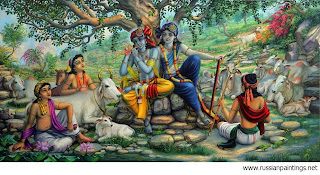




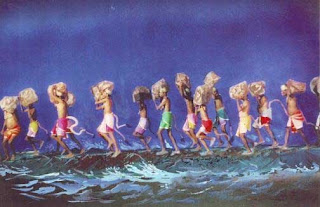
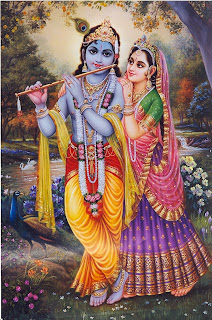







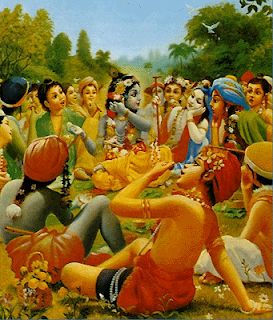



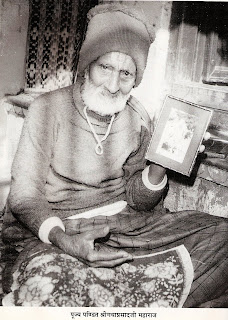

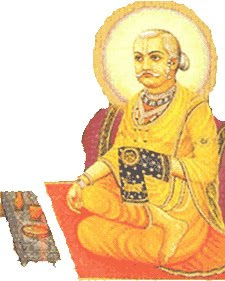


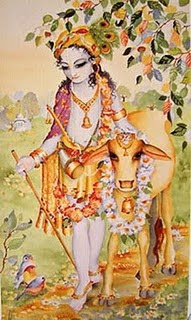




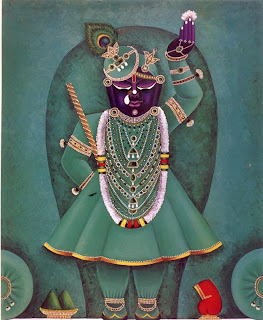
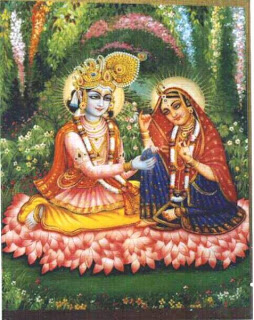




Leave a Reply